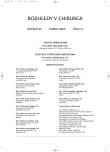The Radial Artery in the Myocardial Revascularization. Analysis of the Patient Subjects
Authors:
J. Čanádyová; M. Šetina; A. Mokráček; D. Čoček; L. Pešl *
Authors‘ workplace:
Kardiochirurgické oddelenie, Nemocnica České Budějovice, a. s.
; Kardiologické oddelenie, Nemocnica České Budějovice, a. s.
*
Published in:
Rozhl. Chir., 2005, roč. 84, č. 4, s. 159-162.
Category:
Monothematic special - Original
Overview
Introduction:
The use of arterial grafts in the myocardial revascularization procedures has grown more popular due to their long-term patency compared with that of the great saphenous vein. The aim of this retrospective study was to assess our experience and first results in the group of patients who had underwent revascularization procedures using their radial artery.
Material and methodology:
Between 7/2000 – 2/2004, 51 patients of acceptable age, aged 69.0 ± 9.0 (42–82), underwent the revascularization procedure using the radial artery in combination with the left or right arteria mammaria interna. The angiographic examinations were conducted in 44 patients (86.3%), 5 patients refused to undergo their control angiographic examinations. Two patients exited a few months following their surgery, however there was no obvious connection with the use of the radial artery graft.
Results:
Out of 44 patients (86.3%), who had their control angiographic examination completed, 9.4 ± 9.8 months later, on average, (1–38 months), 5 patients (11.4%) suffered from the RA occlusion. In 4 patients, the occlusion was located at the branching site off the aorta, in 1 patient the occlusion was located at the site of the anastomosis with the left arteria mammaria interna. The total patency of the radial artery grafts reached 89%.
Conclusion:
The use of the radial artery in myocardial revascularization procedures has proven safe, associated with lower complication rates connected with its collection. Furthermore, the procedures result in a good short and mid-term graft patency confirmed also on the control angiofraphic examinations.
Key words:
the radial artery – myocardial revascularization – angiography
Labels
Surgery Orthopaedics Trauma surgeryArticle was published in
Perspectives in Surgery

2005 Issue 4
Most read in this issue
- Carcinoids of the Appendix
- Prevention, Diagnosis and Treatment of Iatrogennic Lesions of Biliary Tract during Laparoscopic Cholecystectomy. Managament of Papila Injury after Invasive Endoscopy. Part 1.
- Cooperation between a Surgeon and a Gastroenterologist in the Management of Vascular Complications of the Liver Cirrhosis
- Surgical Therapy of Iatrogenic Injury of Biliary Tract after Cholecystectomy and Invasive Endoscopy. Part 2.
